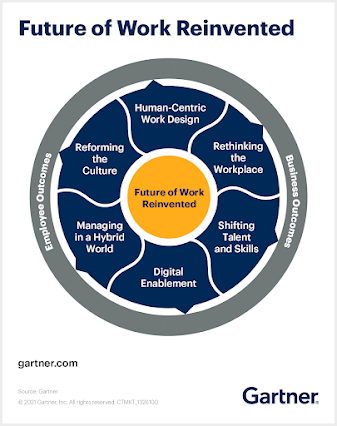For the future of work to deliver positive outcomes for both organizations and their employees, act on six key facets of work.
Just as the internet launched a new digital era, COVID-19 has triggered a new work age. It’s a chance to intentionally rethink who, where, when and how we work — and create a win-win for both people and organizations. It’s exciting, and the expectations are high.
So far, even organizations that have thrived in remote and hybrid set-ups have largely been responding tactically — accommodating the change thrust on us by the pandemic. That’s probably why the long-held assumption (or knee-jerk reaction) of many is to “return” to work.
But there’s no going back. And why would we? We have an incredible chance to capture our lessons learned, absorb the best and lose the rest.
What we’ve learned about the future of work
Employees proved during the pandemic that working in employer-controlled workspaces doesn’t have to determine their productivity or engagement. They’ve also discovered that flexibility can help them feel more successful not just at work, but as people — as parents, caregivers, social activists or however they choose to define themselves.
It’s not surprising, then, that many who have experienced the flexibility of hybrid and remote working environments aren’t keen to go back.
Many employers agree that it’s no time to regress. It’s time to leverage flexibility and extend it further — beyond location into all aspects of who, where, when and how we achieve work productively. Those organizations that figure this out will have a competitive edge — in attracting talent, outsmarting their competition and achieving their business goals.
Failure to act creates risk — talent risk, competitive risk, business risk.
Don’t ignore the future of work data
Consider the mounting evidence. Recent Gartner survey data from more than 4,000 employees shows:
- 39% of employees are likely to leave if you insist on a “hard return” — a wholesale return to a fully on-site experience.
- 55% of employees say their ability to work flexibly will impact whether or not they stay with their employer.
- Among employees who are currently working remotely or in a hybrid arrangement:
- 75% say their expectations for working flexibly have increased.
- Only 4% say they would prefer to go work on-site full time.
Senior leaders who favor returning to physical locations, old workstreams and work styles may doubt that employees will vote with their feet, but our conversations with clients confirm that employees are already walking away from organizations that won’t consider hybrid working arrangements.
And if you haven’t decided or articulated your policies publicly, your employees are assuming the worst.
Data shows the opportunities, too
The benefits of these new work dynamics are equally evident in performance and other key drivers of success, such as innovation and risk-taking.
- 62% of knowledge workers are high performers when afforded significant work flexibility versus 27% of those provided with little flexibility.
- Employees are 3 times more likely to be high performers when given flexibility over where, when and how they work.
- Among knowledge workers, high levels of enterprise contribution are most common among those who are fully remote.
- Hybrid teams are most likely to show high levels of inclusion (fully on-site teams are least likely).
And despite widely voiced concerns about culture and innovation, Gartner data shows that fully on-site teams are least likely to show high levels of engagement, trust or discretionary effort, are least comfortable taking risks and least likely to provide opportunities to innovate outside of meetings.
Reinvent work principles in key pillars
The question now is how we move intentionally from legacy work models. And physical location isn’t the only issue. We need to shed a host of outdated and outmoded legacy practices that today are adding to our employees’ exhaustion.
It’s time to reinvent key pillars of where, when and how we work to create sustainable working conditions that maximize employees’ engagement, collaboration and productivity.
Gartner sees these pillars as:
- Human-centric work design: Make individual employees more productive by giving them more control over their work and work environment.
- Reforming the culture: Evolve organizational culture to maximize the benefits of hybrid working.
- Managing in a hybrid world: Develop and promote the skills that managers will need to oversee employees in a hybrid work environment.
- Digital enablement: Prioritize technologies and practices needed to optimize hybrid work in the short term and fuel organizational prosperity in the long term.
- Shifting talent and skills: Identify, acquire and develop the skills and competencies employees will need in the digital future.
- Rethinking the workplace: Create a workplace strategy for the postpandemic, hybrid work era.
Only when we intentionally tackle as many of these pillars as possible will we capture the opportunities presented by our reinventing work to be fit for a modern world.




0 Komentar